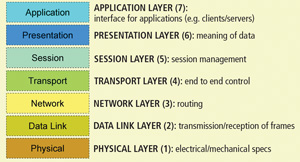
Wireless: The next ‘big thing’?
May 15, 2007
By Ian Verhappen
There is a lot of discussion in the technical journals these days about wireless being the next “big thing.” Like all of the previous big things, including fieldbus about 10 years ago, it will not only take time to develop, but also to prove its suitability to the industrial environment.
Fortunately, because of the OSI seven-layer model, wireless communications will not require changes to the entire network model. The largest impact will be to the physical layer. Of course, there will be changes required at the interface between this layer and the others, especially the data link layer. Other layers may also require changes depending on the network configuration and complexity. More complex networks need additional information to be shared so that they can effectively monitor data packets as they move from the application layer down through to the physical layer, and then again as the information is transferred back up to the application layer.
 The good news is that because wireless is another type of transmission media, the protocols themselves – such as Foundation Fieldbus, HART, Profibus and Modbus, which typically reside in the user layer above the application layer – will be able to operate on the wireless standard when it is complete.
The good news is that because wireless is another type of transmission media, the protocols themselves – such as Foundation Fieldbus, HART, Profibus and Modbus, which typically reside in the user layer above the application layer – will be able to operate on the wireless standard when it is complete.
Another consideration is the frequency to use for the communications. The higher the frequency, the better the signal integrity, but the shorter the distance that it can be transmitted. Of course, all you need to do to overcome the distance limitation is build a more powerful transmitter-receiver, which will soon run against the limits imposed by the wireless unit being battery powered and require a wire, which defeats the purpose of the exercise. Alternately, you could use large batteries or change them regularly, so you substitute cable for battery changers. (Wireless sensor developers are targeting a 10-year life between service cycles.)
Security is another potential issue. How many of you know your cell phone is about to ring because your laptop picks up the signal from the tower before your phone actually starts ringing? That tells you something about the ISM (Industry, Science Medical) unlicensed bands and how much they are being used. These issues need to be addressed for industrial automation to ensure that signals used, not only for monitoring but eventually for control, will be transmitted when required and not be corrupted in the process of getting from A to B.
The ISA-100 committee is working to address these needs, but it may take some time. Every time a change has been made to the physical layer used for industrial communications, it has taken 10 years to be approved and then about another 10 before it is widely adopted. This has been true for pneumatics, analogue and fieldbus, so if we can get this work done in less time, it will be a huge accomplishment. The ISA-100 committee now meets monthly to help push the effort forward.
There are many challenges associated with the development and introduction of any new technology, but once the problems are resolved, the opportunities are significant.
Next month, we’ll talk about the efforts underway to provide tighter integration of motors and drives for today’s control systems.
Bus bits
- The Fieldbus Foundation will have an end-user council seminar in Calgary on June 21. To find out more, visit www.fieldbus.org.
- ODVA recently issued the first edition of The CompoNet Specification. The new specification now joins the CIP Networks library of specifications, including EtherNet/IP, DeviceNet, ControlNet and CIP Safety. CIP, the Common Industrial Protocol, is a single, media-independent protocol that provides the interoperability and interchangeability essential to open networks and open systems.
- A Europe-wide series of proposals on how to manage the information available via radio frequency identification (RFID) tags has recently been unveiled. The proposals are meant to address the privacy concerns of citizens to boost consumer confidence. The commission working on the proposals will: create an RFID stakeholder group to provide advice and assistance in developing a European policy position concerning RFID applications; propose amendments to the e-Privacy Directive to take account of RFID applications, as part of the EU telecom rules’ review; publish a recommendation on how to handle data security and privacy of smart radio tags to member states and stakeholders; and, in association with the stakeholder group, analyse the economic and social effects of smart radio tags and other technologies, particularly focusing on privacy, trust and governance, leading to an assessment of policy options and the need for further legislative steps, by the end of 2008.
Ian Verhappen is an ISA Fellow, ISA certified automation professional, adjunct professor at Tri-State University and director of industrial networks at MTL Instruments, a global firm specializing in fieldbus and industrial networking technologies. E-mail him at Ian.Verhappen@ICE-Pros.com, or visit his website at www.ICE-Pros.com.